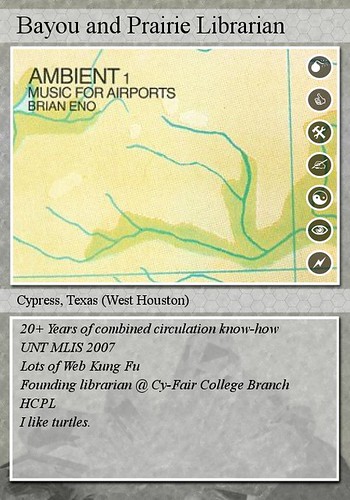
I was first introduced to tagging via the Flickr photo-sharing website, where users can add subject tags to their photos search them, and group them. For example, before my recent vacation to South Padre Island (
click to see the results of such a search), I did a tag search on Flickr for “Padre Island” and was able to get a nice visual preview of the beaches and attractions on the
Island.
I got very excited about tags when, in library school, I was introduced to the concept of a “tag cloud” (image included is a tag cloud for the on-line catalog of the Ann Arbor Public Library), used for searching databases of tags. A tag cloud is a visual (digital) representation of tags, with the words that make up the tags appearing larger or smaller depending on a certain variable element regarding the tags in the database (usually this is the number of items which have a particular tag – tags which have few items associated with them appear small, those with many items appear larger).
Tag clouds struck me as a highly intuitive interface for searching, for example, library catalogs. Tag clouds might be more user-friendly than the search access interfaces for most contemporary integrated library systems. Adding the ability for library patrons to also create their own subject tags for library holdings (in addition to the “official” bibliographic metadata concerning the catalog created by library catalogers) also struck me as a great way to allow users to search using more natural and contemporary language. This kind of collaborative interaction with the collection would simultaneously create community interest and buy-in to the bibliographic resources of a library, as well as creating a new resource for access in itself. A working model of this sort of activity exists already. In the LibraryThing website’s use of tags for books, we see this sort of collaborative action at play, creating social networks for discussion and interest about books both in the public sphere and people’s own private libraries.
Tagging is also an option on in the indispensable bookmarking website, del.icio.us, although what is being tagged there is not books, but websites and on-line resources. For anyone who uses more than one computer and accesses the internet at different locations, del.icio.us is a tremendous resource, allowing immediate retrieval of your essential bookmarks from anywhere in the digital world. Like Karl Malden used to say in the American Express commercials: “don’t leave home without it”.
While use of tags can be helpful as a reference tool, where you can search through users’ tags for various subjects, use of tags is necessary to access and organize the sites and resources which you have collected and bookmarked yourself. The tags, on del.icio.us, are an integral part of the operation of the application itself – kind of a built-in tool.





